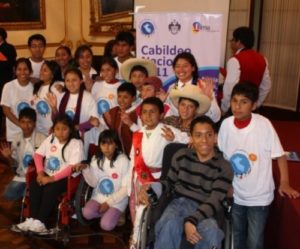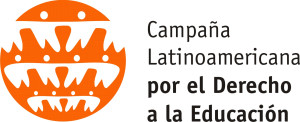Niñas, niños, madres, padres, maestras y maestros abogan por el derecho de la primera infancia a una atención integral
Madeleine Zúñiga: “Great inequality in access and quality is still the challenge of education in Peru”
February 27, 2019
Advances, challenges and priority actions in the struggle for the right to education in Peru in 2019 are some of the topics that were discussed in an interview with Madeleine Zúñiga, national coordinator of the Peruvian Campaign for Education.
The Policy of Education Provision for the Population in the Rural Area, the new National Basic Education Curriculum, the University Law and the National Superintendence of Higher Education University (SUNEDU) were some of the achievements in the education area, in recent years in Peru.
However, to guarantee the human right to education for everyone, the country must still advance in public policies, financing, creation of laws and tax reform. This information is shared with us by Madeleine Zúñiga, national coordinator of the Peruvian Campaign for Education (CPDE), in an interview with CLADE.
According to Madeleine, “the commitments of the Peruvian State with the Education Agenda 2030 and SDG 4 [Sustainable Development Goal 4, referring to education] will not be fulfilled if we have poor teacher training and working conditions that do not improve as they should.”
Read the full interview:
What is the context of education as a right in your country today and what are the expectations for 2019?
Madeleine Zúñiga – Education in Peru has a good legal support. There are no setbacks, rather there are some advances, such as the Policy of Education Provision for the Population in Rural Areas, which will have a universal scope, since it includes young people and adults and non-schooling modalities. The right to education is the main focus of the National Basic Education Curriculum approved in 2016, which also adopts the gender equality approach and principles such as democracy and interculturality. We still have a legal based deb with the people with disabilities, because a national policy that responds to the specificities of relevant quality education for that population is still pending.
The University Law is in force since 2014 and the National Superintendence of Education University (SUNEDU) is playing a fundamental role, as it grants or denies the operating license of public and private universities, considering the basic conditions of quality for tertiary education. The evaluation process to grant the permanent licenses to the universities must finish in 2019.
Despite the strong legal support, the challenge of the right to education in Peru continues to be the great inequality in access and quality of service offered to the most vulnerable population because of their poor status, geographical location (rural on the coast, in the mountains and forests), language, indigenous culture and disability. Considering the life cycles, comprehensive attention to early childhood continues to have a deficit of coverage and quality, especially in terms of adequate infrastructure, although the infrastructure deficit significantly affects about 50% of the classrooms in all Regular Basic Education.
The education for young people and adults also requires much more attention to expand their coverage and design more suitable programs for this population. The aforementioned policy creates expectations about its improvement in rural areas, but does not involve young people and adults in the cities.
 From Peru’s commitments to the 2030 Education Agenda and to the Sustainable Development Goal 4, which deals with education are being met?
From Peru’s commitments to the 2030 Education Agenda and to the Sustainable Development Goal 4, which deals with education are being met?
Madeleine Zúñiga – Although we do not identify setbacks, we can point out stagnation in initial teachers’ training, the implementation of the new curriculum and in budget increase. We consider that the lack of updated preparation of the teaching profession is the most serious one, since it has an impact on and delays any possibility of substantive reform of national education. The commitments of the Peruvian State with the Education Agenda 2030 and SDG 4 will not be met with a weak teacher training and working conditions that do not improve as they should. The development of the new curriculum by competencies, with the demands of approaches such as the right to education, gender, interculturality, care for the environment and others, requires a teachers’ training that we do not have yet.
As for the educational budget, this remains at 3.9% of GDP (Gross Domestic Product), one of the lowest in South America, which reveals that education does not have the priority announced by the current president Martín Vizcarra. The working conditions of the teaching staff hardly improve: the teachers’ salary had a minimum increase, rising to approximately 600 dollars. Researchers and education researchers link this stagnation of the budget with low tax collection and the urgency of a tax reform that combats tax evasion, which is estimated at 18,000 million dollars.
Free education is a compromise that the Peruvian State will hardly fulfill. Meanwhile, private schools grow even in small and medium-sized cities, without regulation that guarantees their quality.
In the above-mentioned context, what will the priority activities or lines of action be for the Peruvian Campaign this year?

Madeleine Zúñiga – The CPDE hopes to put emphasis on the activities in connection with schoolchildren and young people. We want to develop a project to disseminate the content of SDG 4-Education Agenda 2030 in four regions of the country and define the possibilities of monitoring the progress of two of the targets of SDG 4.
Another activity will be to organize workshops that we will call “Taxation and citizenship”, to raise awareness among schoolchildren and young people about the importance of taxation in the exercise of rights such as education, and how detrimental is tax evasion for the country’s economy and the implementation of social policies.
We highlight three activities that we carry out in dialogue with state sectors, such as the Ministry of Education (MINEDU), the Ministry of Justice and Human Rights (MINJUSDH) and the Ministry of Development and Social Inclusion (MIDIS). We are part of the Technical Board of Adolescent Education, which aims to develop a new adolescent education policy that responds appropriately to the diversity of the adolescent population in the country.
We will also continue participating in the EPU Collective for children, adolescents and youth, whose objective is to follow up on the recommendations given to Peru by international human rights organizations, in the context of the national evaluation carried out through the UN Universal Periodic Review (UPR). We are attending the meetings with the Ministry of Justice and Human Rights, to discuss a proposal for an inter-institutional protocol for the preparation of reports and for the follow-up of recommendations of international human rights organizations, as well as the progress of State reports, submitted to the Committee of Human Rights and the Committee on Economic, Social and Cultural Rights (DESC) of the UN.
As a member of the Inter-Institutional Collective for the Rights of Children and Adolescents of the Round Table for the Fight against Poverty, the CPDE participates in its activities. We are currently participating in the consultation for the elaboration of a national policy of social inclusion that will have intersectoral and intergovernmental scope. Through this policy we defend and take care of a rights-based approach, interculturality, territoriality, gender and life cycles, to include early childhood and adults and the elderly.
Related Content





